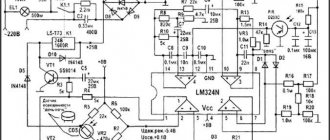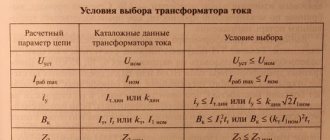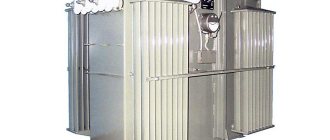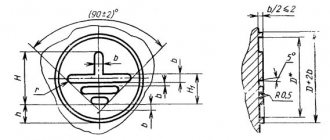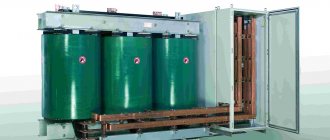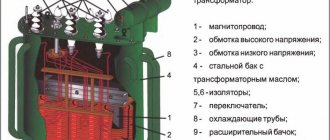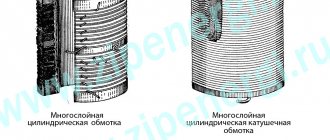A power transformer is a complex piece of equipment that requires periodic maintenance. This allows you to ensure its stable operation for a long time. Major and “current repairs of power transformers” are carried out at a certain frequency and according to an established scheme. “Between overhaul tests of the power transformer” are also carried out. Features of maintenance and repair of the presented units will be discussed further.
Varieties
There are several types of power equipment repairs. If you need to service a large high-power device, for example, 1600 kVA, 2500 kVA, 6300 kVA, etc., you cannot do without special skills. Special equipment should only be inspected and repaired by a qualified professional.
The following types of repairs are distinguished:
- Maintenance. Produced according to the schedule established by regulations. In this case, the operation of the equipment does not stop.
- Routine repair of power transformer. Requires disconnecting the device from the network. Refers to preventive actions.
- Overhaul of transformers. Measures are taken to eliminate malfunctions that arose during operation of the unit, as well as in case of aging and wear of the system. After 10–15 years of operation of the installation, it must be reconstructed.
In addition to the presented actions, between-repair and “post-repair” tests are carried out. For devices with a power of more than 110 kV, the first major maintenance is required 12 years after the start of operation. For other varieties, similar actions are performed based on test results and general condition.
Inspection of “power oil transformers” and units with an oil cooling system such as “TSZM”, “TSZN” and other varieties that contain adjusting elements (OLTC) is required once a year. For devices without an on-load tap-changer, this type of maintenance is performed every two years.
For other types, maintenance is required at least once every four years. There are also special instructions. They are used in places of increased pollution.
Overhaul tests are carried out in accordance with the rules established by the PPR (works project).
Cost of services
Prices are for 2022, including VAT (in rubles)
| type power kVA | audit | repair set | cap. repair without changing windings | repair set | cap. repair with replacement of HV | cap. repair with change of LV | cap. repair with replacement of HV+LV | repair HV, LV kit | repair HV+LV set |
| Up to 63 | 29400 | 8406 | 57490 | 22824 | 95130 | 99290 | 112370 | 29700 | 30640 |
| 100 | 34960 | 11170 | 65880 | 22900 | 108990 | 114570 | 121700 | 29780 | 33540 |
| 160 | 37520 | 11560 | 74340 | 25024 | 129470 | 131290 | 142906 | 33940 | 34840 |
| 180 | 39134 | 12016 | 90320 | 25974 | 134090 | 139660 | 150420 | 34460 | 39300 |
| 250 | 43340 | 12698 | 92510 | 26156 | 138910 | 144920 | 156420 | 38106 | 42180 |
| 320 | 57030 | 12902 | 109060 | 31956 | 171730 | 179948 | 188360 | 43360 | 45160 |
| 400 | 60090 | 12956 | 113740 | 32088 | 174040 | 191320 | 205978 | 41560 | 42894 |
| 560 | 65630 | 13970 | 135580 | 40400 | 178210 | 188900 | 218698 | 57470 | 60200 |
| 630 | 71260 | 16176 | 137760 | 41798 | 241860 | 237220 | 271840 | 56886 | 60680 |
| 1000 | 97120 | 20534 | 168260 | 49210 | 335600 | 357800 | 374900 | 88152 | 92368 |
| 1600 | 158818 | 25660 | 278580 | 68450 | 534900 | 625300 | 511740 | 115356 | 120836 |
| 2500 | 199740 | 35374 | 429500 | 84352 | 672480 | 908540 | 1153348 | 124170 | 129288 |
Are you interested in prices for repairing oil transformers in Moscow? Our electronic catalog includes basic prices for all types of services we provide. However, we will be able to accurately calculate how much repairs will cost only after diagnosing the transformer, assessing its condition and the amount of work to be done. To do this, contact us in a way convenient for you and call a specialist to your site. We will agree on the optimal time and solve your problem quickly and inexpensively.
Maintenance
The maintenance process is carried out at certain intervals. The procedure is clearly regulated. It includes several mandatory steps:
- Inspection of the “transformer” device from the outside, identifying possible malfunctions and damage to the housing.
- Cleaning the tank and insulators.
- Elimination of dirt deposits in the expander.
- Add “oil” (if necessary), examine the condition of the coolant level indicator.
- Thermosiphon type filters are inspected. If necessary, the sorbent is changed in them.
- The condition of the circulation pipes, fuse, seals, and welds is assessed.
- For a device with an oil cooling system, samples of the internal fluid are taken.
- “Power transformers are tested” and the main indicators of their operation are measured.
Using a certain technology, the condition of the installation is assessed after maintenance.
How the device works
Carrying out any technical work may also depend on a certain type of unit. The simpler the design, the less maintenance is required, and the process itself is somewhat easier. Possible types of work depend on a number of technical parameters of the transformer: the number of windings and the number of phases.
Converted current flows continuously through the connected device. In this case, the magnetic flux penetrates all the windings and induces an EMF in them. There is also an idle mode. In this case, the secondary winding is deprived of any load. This example generally illustrates the operation of a simple single-phase transformer.
Current repairs with dry cooling type
Equipment with dry cooling type has cast insulation. It is easy to use and not fussy. Maintenance of such a device is carried out according to established regulations. Its points depend on environmental and operating conditions. The process is carried out according to the following scheme:
- The cooling system should be checked every six months. If fans (forced ventilation) are installed in the structure, the quality of their operation must be assessed. It is important to determine the performance of the temperature controller.
- The surface of the device is cleaned of various contaminants. This procedure is carried out once every quarter or six months. If the environment has a high level of pollution, cleaning is carried out more often.
- Once a year the hull is examined for cracks. If necessary, they should be eliminated immediately.
- The integrity of insulation and protection of metal structural elements is checked. The inspection is performed once a year.
- The fixation of the winding must be strong. It is checked during technical inspection. If damage is detected in the cast winding, it is completely replaced.
Caring for dry type devices requires less effort and time. This is due to the lack of liquid in the system, the condition of which must be constantly monitored. Oil varieties need to be examined more carefully.
Drying and impregnation of windings
Until about the 60s, electrical engineering factories and repair shops impregnated transformer windings. Then VEI scientists proved that impregnation improves the electrical insulating properties of windings very little, and in order to simplify the technology for manufacturing windings, impregnation with varnishes was recommended. Currently, almost all electrical engineering plants do not impregnate transformer windings. However, it should be noted that impregnation of the windings improves the mechanical strength of the windings. With conventional impregnation, the varnish penetrates the first 2...3 layers of the winding and partially cements it. When using ultrasound to impregnate windings, the varnish penetrates more deeply into the insulation, and the insulation characteristics and mechanical strength of the windings are noticeably improved. It is necessary to dry the transformer windings both when replacing them with new ones and after repairing them. This can be done both in stationary furnaces and at the transformer repair site. Drying can be carried out using vacuum (more advanced drying) or without it, in the presence of natural or artificial ventilation. Heaters in stationary furnaces can be very different: steam, induction, electric. The most commonly used are electric heaters; they are usually calculated using empirical formulas. For example, where Pnag, Sh is the power of the heater (kW) and the rated power of the transformers simultaneously subjected to drying, kVA. The fan flow (m3/h) is determined from the calculation of QB = 0.6 Rya at a furnace temperature of about 100°C, an ambient air temperature of 10...15°C and a furnace volume of 2.5...3.5 m3. The surface of the heater is determined from the expression. Using the same expression, the material of the heater is selected and all its other characteristics and the power of the furnace are obtained. Drying of the transformer in its own tank can be done with hot oil with filtration of the latter, hot air from the heater (blower), short circuit current, losses in the tank (using a magnetizing winding) and zero sequence current. The last two drying methods are most widespread. They are described in some detail in the workshop for laboratory work. Progressive methods include drying by infrared irradiation. It can be carried out using a stationary chamber with or without heaters, indoors or outdoors. Heating is carried out by infrared lamps with mirror reflection, which are mounted in portable sections on all sides of the active part of the transformer at a distance of at least 300 mm. The energy density of one lamp is 0.3 W/cm2, reaching 0.4 W/cm2 for large lamps. In transformers of sizes I and II, the total power of the lamps required for drying ranges from 6 to 12.6 kW, the drying duration is from 18 to 28 hours. With this drying method, moisture moves from the inner layers to the outer, which speeds up the drying process. The disadvantage of this method is the scarcity and high cost of infrared lamps. If necessary, you can use incandescent lamps with a power of 20% more, but with a supply voltage supplied to them 10% lower than the nominal one.
Current repairs with oil type cooling
The complexity of routine troubleshooting of a device with an oil cooling system depends on the complexity of its design and operating features. The composition includes a tank filled with oil. This structural element requires special attention. Maintenance is carried out according to the following scheme:
- The process is carried out without transporting the unit, at the place of its installation.
- The body is inspected and external defects are identified.
- Minor faults in the fittings, cooling system and hanging units are eliminated.
- The fasteners are tightened tighter. If there is a leak, it must be sealed. Oil is added.
- The silica gel in the thermosyphon filter is changed.
- The body is cleaned of dirt.
- The resistance of the insulating material on the windings is measured.
Video: Routine repair of a 35 kV power transformer
The above steps are completed within 1–2 days. In this case, the working part of the transformer is not affected.
Transformer defects
Once assembled, the transformer is inspected, the presence and condition of thermometers, blow-out fuses, plugs, covers, air dryers, etc. are determined, the absence of oil leaks is ensured, the condition of the inputs is checked, and an oil sample is taken for breakdown testing and chemical analysis. Then drain the oil to a level below the sealing gasket of the lid, begin to lift the removable part, simultaneously washing it with a stream of oil (you can take it from your own tank and drain it into it). At the same time, inspection and defect detection of the active part continues. Malfunctions of electrical circuits of transformers (open circuit, short circuit between circuits or circuits and the housing, and turn short circuit) can be easily determined using a megger or test lamp, the current or voltage symmetry method, and the voltage drop method. It is extremely difficult to assess the insulation state of individual transformer units. For example, the condition of electric cardboard is determined on samples cut from several places (yoke, sections, etc.), bending the sample with your fingers, first at a right angle, and then without squeezing the bend up to 180°. The quality of the insulation is judged by the presence or absence of cracks and kinks. The quality of fibrous insulation can also be determined by characteristic breaks and shortening of the length of an elementary fiber, examining samples of insulation (for example, coil insulation) under a microscope. The greater the proportion of damaged fibers (according to the classification from 5 to 80%), the worse the condition of the insulation. In some cases, the condition of the insulation is assessed by mechanical strength, determined by “scraping” with a fingernail or knife, and by the degree of its darkening. However, well-impregnated insulation with an extreme degree of aging often cannot be scraped off, and when the winding is deformed, for example, during through short circuits, it is completely destroyed and falls off the conductor. Fresh but moistened insulation can be mechanically strong, but have low intrinsic resistance, while aged insulation can have significant resistance and hardness and even mechanical strength. It is no coincidence that a whole range of measurements is currently used to determine the degree of moisture in transformer insulation: breakdown testing and abbreviated chemical analysis of the oil, measurement of insulation resistance R60 and determination of the absorption coefficient R60/R15, measurement of tgδ and absorption characteristics. L.M. Rybakov proved that in transformers in various operating modes there is always heat and mass transfer between oil and solid insulation, and there are strict correlations between some physicochemical, mechanical and dielectric characteristics. It has been theoretically proven and experimentally confirmed that the presence of water, the amount of water-soluble acids and tgδ are collectively a universal indicator of the state of the transformer insulation system: humidification, oxidation, aging
Major renovation
Overhauls of power transformers include the entire list of routine maintenance work, as well as the elimination of possible malfunctions of the “windings,” core, and switches. During this procedure, the winding connections at the terminals and points of contact with the voltage switch are inspected. The condition of the oil tank, pipelines, expanders, and conclusions is examined.
In Russia, a major type of maintenance can be deep or involves opening the oil tank. This is a complex procedure that must be performed by trained professionals.
Video: Overhaul of 110 kV transformer
Deep overhaul
During a major restoration, the equipment is disconnected from the network. If deep maintenance is required, a number of sequential actions are taken:
- The installation housing opens.
- The active part rises.
- The windings are disconnected from the magnetic drive.
- The coils are rewound in accordance with the design features.
- The main insulation is restored or completely replaced.
- The functioning of the magnetic system is adjusted.
- Bends, inputs, coolers and switches, fans, oil pumps and oil shut-off valves are subject to replacement or restoration.
This is a complex process that requires highly qualified craftsmen, regardless of the type of device. In some cases it will be necessary to open the oil tank. To do this, after carrying out the above steps, you need to dry the working part. The tank is examined at a special site. In this case, the power must be completely turned off.
Our advantages
By ordering a major overhaul or routine maintenance of transformers from our company, you receive:
- competent, responsible and comprehensive approach to restoration work;
- full legal support of the transaction, drawing up an agreement, estimates;
- 12 month guarantee for work performed;
- prompt order fulfillment;
- favorable terms of cooperation and attractive prices.
This complex type of work can only be entrusted to professionals, so contact PromElectroRemont CJSC.
In the prices section you can see the current prices for our services.
Prevention trials
Testing the operation of equipment after prevention also goes through a number of successive stages. First of all, the conditions for turning on the device are studied. “Winding” resistances are measured. Next, the deviation of the dielectric losses of the insulation of the coils is measured.
At the next stage, the correct operation of the equipment is determined when connected to an industrial frequency of increased power. The resistance of the windings at direct current is studied. The transformation ratio is checked.
If the unit is of the three-phase type, the group of its connections is checked. When testing single-phase devices, their polarity is measured. Current indicators and no-load losses are studied.
Then the switch, tank and radiators, cooling devices, and indicator are checked. Tests of inputs and built-in currents are carried out.
Main technical characteristics
The operating parameters of the unit will be considered using the example of the TMG transformer model. The abbreviation literally stands for three-phase, with oil and air cooling and sealed design. The technical characteristics of the transformer in this case are expressed in the following parameters:
- the value of the nominal HV;
- power indicator;
- the value of the nominal LV;
- climatic design in accordance with GOST standards;
- type of connection of the device windings.
Among other parameters of the device, one can highlight losses in kW for no-load and short circuit, voltage during short circuit and no-load current as a percentage. These parameters are determined only after acceptance tests, which are mandatory before putting the device into permanent operation. In addition, among the technical characteristics of transformers, it is also worth mentioning the overall dimensions and weight. Indicators can vary greatly depending on the power output of the unit.
Emergency situations
In some cases, the inspection may be carried out in an emergency situation. It may occur when strong crackling or uneven noise is detected inside the housing. The equipment requires unscheduled inspection if the heating level is abnormal. It may gradually increase.
In some cases, oil is released, leaks (the liquid level drops below the permissible value), and the diaphragms of the expansion pipes are destroyed. In this case, the installation cannot function normally. It is required to perform its emergency recovery.
Oil samples may be taken after maintenance or during testing. If the quality of the substance is unsatisfactory, the power is turned off. An emergency fluid change is in progress.
Abnormal humming
If an abnormal hum is detected inside the case, there may be several reasons for this condition. It is caused by loosening of cover bolts or other parts. They will need to be tightened.
With increased voltage in the network, noise may appear. To fix it you will need to move the switch to the correct position. If the pressing is broken, a humming noise appears at the joints inside the magnetic circuit. The core will need to be repressed. If the outermost sheets of the magnetic circuit begin to vibrate, noise may be heard. They need to be wedged.
Humming is also caused by equipment overload (it needs to be reduced), uneven loading of phases or a short circuit between them or winding turns.
In addition to the listed faults, breaks may appear in the turns of the coils if they are connected poorly. If a similar situation is detected in the primary winding, a change in the secondary voltage will occur.
To determine the scope of work in an emergency situation, a transformer defect detection process is carried out. This allows you to determine the severity and nature of the damage. Based on the analysis, the need for materials, devices and tools necessary for troubleshooting is established.
Power transformers, like any equipment, require periodic maintenance. To avoid the need to troubleshoot in emergency mode, periodic technical inspections and a set of capital measures are carried out to restore system elements.

